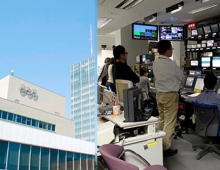
Japanese NHK To Offer Ultra High Definition TV in Ten years
Japan public broadcaster NHK is planning public previews of its developing Ultra High Definition (UHDTV) television system, and expects trials of UHDTV broadcasting to begin in Japan in 2020.
Ultra High Definition (UHDTV) promises images that contain almost 16
times more picture information that that which is found in today's HDTV
systems. UHDTV accommodates 8K resolution, meaning that it contains 7,680
horizontal pixels x 4,320 vertical pixels. This is significantly more
picture information than that which is contained in today's HDTV formats,
as well as digital cinema images.
NHK talked about the status of Ultra High Definition Television (UHDTV) at the Society of Motion Picture and Television Engineers' annual Technical Conference and Expo at Hollywood & Highland.
The frontiers of video technology are being pushed to new limits with advanced work on UHDTV2. Progress continues to be made in key areas, including image capture, processing, and display technologies. NHK presented a camera system using three 33-M-pixel CMOS image sensors for UHDTV. At a paper presented, NHK described a world?s-first camera system that can capture images complying with the highest-level image format specified in SMPTE 2036-1?i.e. UHDTV2 (7680?4320/59.94p, R/G/B 4:4:4). For this camera system, NHK developed a 33-million-pixel CMOS image sensor, an ultrahigh-resolution lens, and a signal-processing function for correcting lens chromatic aberration in real time. As a result, the limiting resolution of captured images was achieved over 4,000 TV lines. Moreover, WDM optical interface with nine 10G-SDI modules was developed. Using this technology,the camera head and camera-control unit can be connected by an SMPTE 311 camera cable.
NHK is also developing Super Hi-Vision (defined as UHDTV-2 in SMPTE2036-1; henceforth, SHV) capable of providing a highly realistic viewing experience. To achieve a more practical system, NHK developed SHV camera and SHV recorder/player both with greater compactness and mobility. Miniaturization of this camera was realized through the adoption of a compact 10G-SDI-based optical transmission unit and high-integration signal processing unit. With 16 H.264/AVC compression units developed for HD operating in parallel, the compact recorder/player record contents on 16 semiconductor memory cards (P2 cards) per hour. NHK was able to make both the camera and the recorder/player less than half the size of existing systems. Superimposing control and status data on the ancillary data area of 1.5G-SDI also ensures improved operability and editing flow efficiency of these devices, NHK said.
Besides capturing and storing, the UHDTV content should be transmitted. NHK detailed a new technology for Digital Terrestrial Broadcasting?Toward Digital Terrestrial Broadcasting of UHDTV. The company is conducting research on the next generation of digital terrestrial broadcasting to enable large-volume content services such as UHDTV. It has developed a high-capacity transmission technology for the next-generation broadcasting system and have conducted successful field tests in which 60-Mbps signals (four HDTV programs) were transmitted on a single, 6-MHz terrestrial broadcasting channel. The system uses ultra-multilevel OFDM and dual-polarized MIMO technologies. Ultra-multilevel OFDM increases transmission capacity by extending the carrier modulation scheme from 64QAM, used in current digital terrestrial broadcasting, to 1024QAM. The company has also demonstrated dual-polarized MIMO technology, which enables two different signals to be transmitted simultaneously using horizontally and vertically polarized waves. It also accurately separates and demodulates the two signals.
NHK plans to expose the public to its system in 2012, by shooting some of the London Olympics in Ultra High Definition, which is also referred to as Super Hi-Vision. The footage would be transmitted to public viewing sites in the U.K., U.S. and Japan.
A challenge for UHDTV could be the size of the required TV sets, in order to produce the high-resolution format. An NHK spokesperson at SMPTE explained that the broadcaster is currently working on various size consumer LCD TV sets, including in the 80- to 90-inch range.
Plans call for trials of UHDTV broadcasting to begin in Japan in 2020.
NHK talked about the status of Ultra High Definition Television (UHDTV) at the Society of Motion Picture and Television Engineers' annual Technical Conference and Expo at Hollywood & Highland.
The frontiers of video technology are being pushed to new limits with advanced work on UHDTV2. Progress continues to be made in key areas, including image capture, processing, and display technologies. NHK presented a camera system using three 33-M-pixel CMOS image sensors for UHDTV. At a paper presented, NHK described a world?s-first camera system that can capture images complying with the highest-level image format specified in SMPTE 2036-1?i.e. UHDTV2 (7680?4320/59.94p, R/G/B 4:4:4). For this camera system, NHK developed a 33-million-pixel CMOS image sensor, an ultrahigh-resolution lens, and a signal-processing function for correcting lens chromatic aberration in real time. As a result, the limiting resolution of captured images was achieved over 4,000 TV lines. Moreover, WDM optical interface with nine 10G-SDI modules was developed. Using this technology,the camera head and camera-control unit can be connected by an SMPTE 311 camera cable.
NHK is also developing Super Hi-Vision (defined as UHDTV-2 in SMPTE2036-1; henceforth, SHV) capable of providing a highly realistic viewing experience. To achieve a more practical system, NHK developed SHV camera and SHV recorder/player both with greater compactness and mobility. Miniaturization of this camera was realized through the adoption of a compact 10G-SDI-based optical transmission unit and high-integration signal processing unit. With 16 H.264/AVC compression units developed for HD operating in parallel, the compact recorder/player record contents on 16 semiconductor memory cards (P2 cards) per hour. NHK was able to make both the camera and the recorder/player less than half the size of existing systems. Superimposing control and status data on the ancillary data area of 1.5G-SDI also ensures improved operability and editing flow efficiency of these devices, NHK said.
Besides capturing and storing, the UHDTV content should be transmitted. NHK detailed a new technology for Digital Terrestrial Broadcasting?Toward Digital Terrestrial Broadcasting of UHDTV. The company is conducting research on the next generation of digital terrestrial broadcasting to enable large-volume content services such as UHDTV. It has developed a high-capacity transmission technology for the next-generation broadcasting system and have conducted successful field tests in which 60-Mbps signals (four HDTV programs) were transmitted on a single, 6-MHz terrestrial broadcasting channel. The system uses ultra-multilevel OFDM and dual-polarized MIMO technologies. Ultra-multilevel OFDM increases transmission capacity by extending the carrier modulation scheme from 64QAM, used in current digital terrestrial broadcasting, to 1024QAM. The company has also demonstrated dual-polarized MIMO technology, which enables two different signals to be transmitted simultaneously using horizontally and vertically polarized waves. It also accurately separates and demodulates the two signals.
NHK plans to expose the public to its system in 2012, by shooting some of the London Olympics in Ultra High Definition, which is also referred to as Super Hi-Vision. The footage would be transmitted to public viewing sites in the U.K., U.S. and Japan.
A challenge for UHDTV could be the size of the required TV sets, in order to produce the high-resolution format. An NHK spokesperson at SMPTE explained that the broadcaster is currently working on various size consumer LCD TV sets, including in the 80- to 90-inch range.
Plans call for trials of UHDTV broadcasting to begin in Japan in 2020.





















